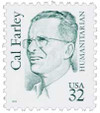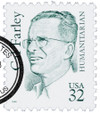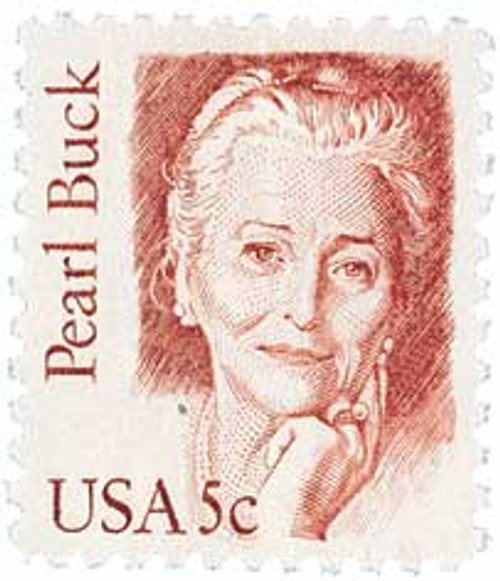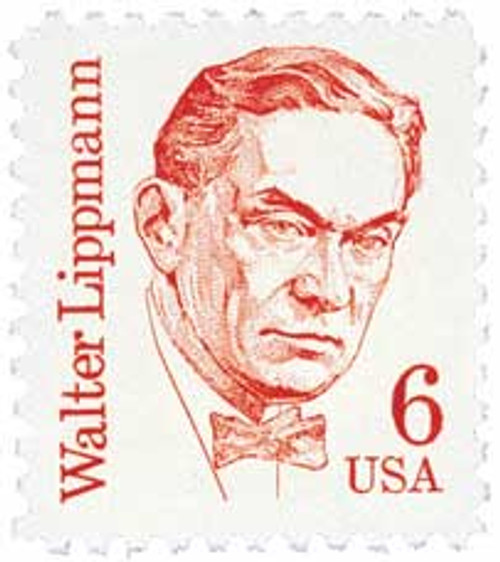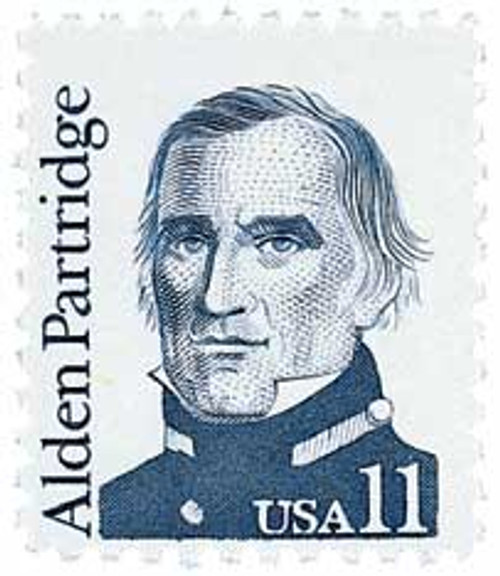
# 2934 - 1996 32c Great Americans: Cal Farley
US #2934
1996 Cal Farley
- 59th stamp in the Great Americans Series
- Honors Cal Farley, founder of Boys Ranch
Category of Stamp: Definitive
Set: Great Americans
Value: 32¢, First Class Mail rate
First Day of Issue: April 26, 1996
First Day City: Amarillo, Texas
Quantity Issued: 150,000,000
Printed by: Banknote Corporation of America
Printing Method/Format: Engraved. Panes of 100 (10 across, 10 down) from printing plates of 400 subjects (20 across, 20 down)
Perforations: 11.2 X 11.1
Color: Green
Reason the stamp was issued: This stamp was issued to commemorate Cal Farley, the founder of Boys Ranch near Amarillo, Texas. This is the 59th face-different stamp in the Great Americans series.
About the stamp design: The India ink portrait of Farley was created by Dennis Lyall, who was also the talent behind the Milton Hershey (#2933) and Mary Cassatt (#2181) stamps. Lyall’s portrait is based on a photo of Farley taken in 1946.
Special design details: The stamp was printed in green to reflect Farley’s love of the outdoors.
First Day City: The First Day of Issue ceremony took place in Amarillo, Texas, where Cal Farley’s Boys Ranch is located. Farley’s daughter was one of the speakers, and a choir and band from the ranch were part of the ceremony.
About the Great Americans Series: The Great Americans Series was created to replace the Americana Series. The new series would be characterized by a standard definitive size, simple design, and monochromatic colors.
This simple design included a portrait, “USA,” the denomination, the person’s name, and in some cases, their occupation or reason for recognition. The first stamp in the new series was issued on December 27, 1980. It honored Sequoyah and fulfilled the new international postcard rate that would go into effect in January 1981.
The Great Americans Series would honor a wider range of people than the previous Prominent Americans and Liberty Series. While those series mainly honored presidents and politicians, the Great Americans Series featured people from many fields and ethnicities. They were individuals who were leaders in education, the military, literature, the arts, and human and civil rights. Plus, while the previous series only honored a few women, the Great Americans featured 15 women. This was also the first definitive series to honor Native Americans, with five stamps.
The Bureau of Engraving and Printing (BEP) produced most of the stamps, but private firms printed some. Several stamps saw multiple printings. The result was many different varieties, with tagging being the key to understanding them. Though there were also differences in perforations, gum, paper, and ink color.
The final stamp in the series was issued on July 17, 1999, honoring Justin S. Morrill. Spanning 20 years, the Great Americans was the longest-running US definitive series. It was also the largest series of face-different stamps, with a total of 63.
History the stamp represents:
Cal Farley (1895-1967) left his home in Iowa to travel to Amarillo, Texas, to play semiprofessional baseball. He later owned his own store. During his free time, Farley organized the Maverick Club, an athletic program for at-risk boys.
In 1939, a rancher gave him 150 acres of land, and Farley built Boys Ranch. He started with nine boys and the ranch grew to over 400. Troubled boys lived and were educated on the property. Farley’s philosophy was “Furnish a boy with a shirttail to hang on to, and you’ll never have to furnish him a room in the reformatory.”
During World War II, Farley began Kids Inc., an athletic program for children whose parents were involved in the war effort. That program continues to give opportunities to the children of Amarillo.
The work Cal Farley began continues to grow. There is now a Girlstown and Family Program to address additional needs.
US #2934
1996 Cal Farley
- 59th stamp in the Great Americans Series
- Honors Cal Farley, founder of Boys Ranch
Category of Stamp: Definitive
Set: Great Americans
Value: 32¢, First Class Mail rate
First Day of Issue: April 26, 1996
First Day City: Amarillo, Texas
Quantity Issued: 150,000,000
Printed by: Banknote Corporation of America
Printing Method/Format: Engraved. Panes of 100 (10 across, 10 down) from printing plates of 400 subjects (20 across, 20 down)
Perforations: 11.2 X 11.1
Color: Green
Reason the stamp was issued: This stamp was issued to commemorate Cal Farley, the founder of Boys Ranch near Amarillo, Texas. This is the 59th face-different stamp in the Great Americans series.
About the stamp design: The India ink portrait of Farley was created by Dennis Lyall, who was also the talent behind the Milton Hershey (#2933) and Mary Cassatt (#2181) stamps. Lyall’s portrait is based on a photo of Farley taken in 1946.
Special design details: The stamp was printed in green to reflect Farley’s love of the outdoors.
First Day City: The First Day of Issue ceremony took place in Amarillo, Texas, where Cal Farley’s Boys Ranch is located. Farley’s daughter was one of the speakers, and a choir and band from the ranch were part of the ceremony.
About the Great Americans Series: The Great Americans Series was created to replace the Americana Series. The new series would be characterized by a standard definitive size, simple design, and monochromatic colors.
This simple design included a portrait, “USA,” the denomination, the person’s name, and in some cases, their occupation or reason for recognition. The first stamp in the new series was issued on December 27, 1980. It honored Sequoyah and fulfilled the new international postcard rate that would go into effect in January 1981.
The Great Americans Series would honor a wider range of people than the previous Prominent Americans and Liberty Series. While those series mainly honored presidents and politicians, the Great Americans Series featured people from many fields and ethnicities. They were individuals who were leaders in education, the military, literature, the arts, and human and civil rights. Plus, while the previous series only honored a few women, the Great Americans featured 15 women. This was also the first definitive series to honor Native Americans, with five stamps.
The Bureau of Engraving and Printing (BEP) produced most of the stamps, but private firms printed some. Several stamps saw multiple printings. The result was many different varieties, with tagging being the key to understanding them. Though there were also differences in perforations, gum, paper, and ink color.
The final stamp in the series was issued on July 17, 1999, honoring Justin S. Morrill. Spanning 20 years, the Great Americans was the longest-running US definitive series. It was also the largest series of face-different stamps, with a total of 63.
History the stamp represents:
Cal Farley (1895-1967) left his home in Iowa to travel to Amarillo, Texas, to play semiprofessional baseball. He later owned his own store. During his free time, Farley organized the Maverick Club, an athletic program for at-risk boys.
In 1939, a rancher gave him 150 acres of land, and Farley built Boys Ranch. He started with nine boys and the ranch grew to over 400. Troubled boys lived and were educated on the property. Farley’s philosophy was “Furnish a boy with a shirttail to hang on to, and you’ll never have to furnish him a room in the reformatory.”
During World War II, Farley began Kids Inc., an athletic program for children whose parents were involved in the war effort. That program continues to give opportunities to the children of Amarillo.
The work Cal Farley began continues to grow. There is now a Girlstown and Family Program to address additional needs.







